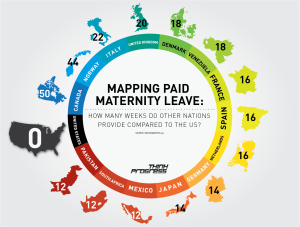
Picture of a protest sign, advocating against pregnancy discrimination. Picture taken from: https://hbr.org/2014/12/pregnant-workers-have-rights-no-matter-what-the-supreme-court-says-about-ups
In our years of education, from the very beginning of preschool, to being college students now, we often remember our female teachers acting as “mother-figures” throughout our school years.
A lot of the time we don’t think about our teachers’ lives outside of school with their family, children and how hard it sometimes is when they decide to have them. Talking about women in education, we can not just talk about the pay gap and not talk about pregnancy discrimination.
What is Pregnancy Discrimination?
According to the American Association of University Women (AAUW), women are faced with discrimination’s such as being fired, bypassed promotions, and employers not holding their job open when they go on maternity leave.
There are many cases of women not being hired to a job, being fired from a current job, or losing promised money from an employer simply because she is pregnant.
In an effort to stop this discrimination of women, The Pregnancy Discrimination Act was passed by the United States in 1978 as a federal statute. The act is apart of the Civil Rights Act of 1964, and prohibits sex discrimination based on pregnancy.
This legislature prohibits the discrimination of women being fired, by-passed or having their jobs not held because of “pregnancy, childbirth, or related medical conditions”.
What to know:
- According to the U.S. Equal Employment Opportunity Commission, the Pregnancy Discrimination Act “forbids discrimination based on pregnancy when it comes to any aspect of employment, including hiring, firing, pay, job assignments, promotions, layoff, training, fringe benefits, such as leave and health insurance, and any other term or condition of employment.”
- If an employer allows temporary leave for disabled employees, then it must also be offered to employees temporarily disabled due to pregnancy.
- In order to be eligible for maternal leave or FMLA, an employee must be working at their job for a year, and work at a job that has 15 or more employees.
- An employee’s job is required to hold their position while they are on their 12 weeks of absence.
- A person who becomes pregnant is not required to tell potential or current employers.
Maternity Leave/FMLA:

Mapping how many weeks employers get for paid maternity leave around the world. Photo taken from: http://thinkprogress.org/health/2012/05/24/489973/paid-maternity-leave-us/
Not only do women face discrimination for pregnancy and child birth, but their rights are also questioned when it comes to maternity leave – “a period of absence from work granted to a mother before and after the birth of her child.”
Maternity leave in the United States is a 12 week, unpaid “break” from work which can be granted to both the mother and father, though most families have only the mother take the leave, which can contribute to the pay gap between genders.
The process women go through with FMLA contributes to the pay gap, making women earn less than men when they take their unpaid leave.
According to the “Council of Economic Advisers Issue Brief of April 2015”, women are likely to leave the work force all together after a pregnancy.
The brief also states that the lack of paid leave in the United States is detrimental to women’s long term salaries and careers.
“Women are more likely than men to take extended time away from their careers when they don’t have access paid leave that allows them to take temporary time off for the birth of a child. Research examining both maternity leave programs in other countries and in California concludes that paid leave can help new mothers maintain a connection to the labor force, and increase the likelihood they return to their employer.”
In comparison to the 12 weeks the United States women get, according to statistics published in the Huffington Post, a lot of other countries not only have a lot more weeks for their leave, but it is also paid leave.
For example, in Iceland the maternity leave is a total of nine months: three months taken by the mother, three months taken by the father, and three months by either parent, with 80 percent of wages paid.
Maternity leave VS. FMLA:
Family Medical Leave Act of 1993, or FMLA, according to the United States Department of Labor, is an act that, “entitles eligible employees of covered employers to take unpaid, job-protected leave for specified family and medical reasons with continuation of group health insurance coverage under the same terms and conditions as if the employee had not taken leave.” FMLA keeps the employees job safe, but also makes the 12 weeks of leave unpaid.
In Lexington, North Carolina
Casey Hudgins, a 9th and 10th grade English teacher in Lexington City schools, is currently using FMLA.
Hudgins recently had a baby girl, Lillian who is now five months old.
Hudgins used the 12 week sick leave offered through FMLA and was lucky to be paid for most of it because of her accumulation of sick days with her school, and went on to take an unpaid leave of absence as an extension.
According to the United States Department of Labor, “Employees may choose to use, or employers may require the employee to use, accrued paid leave to cover some or all of the FMLA leave taken. Employees may choose, or employers may require, the substitution of accrued paid vacation or personal leave for any of the situations covered by FMLA. The substitution of accrued sick or family leave is limited by the employer’s policies governing the use of such leave.”
“I am very grateful that my system allowed me to take an unpaid leave of absence because it has been the best course of action for my family. I also appreciate the extended leave option that allowed me to be paid for 20 additional days even though I had not accumulated them as sick days,” said Hudgins in an email.
Hudgins is currently on an unpaid leave of absence, meaning she is still an employee of her school, but she is not getting paid.
“Ultimately, the way our system is designed women are forced to choose between family and career, and I would love for my daughter to not have to be stuck in the same position 30 years from now,” Hudgins said about the system as a whole.
At WCU:
University Policy 98, last revised on Feb. 22, 2016, is WCU’s policy on “providing it’s faculty with job-protected leave for specified medical and family reasons in accordance with the University of North Carolina (UNC) policies 300.2.11 and 300.2.11[G], the Family and Medical Leave Act of 1993 (“FMLA”), and the North Carolina Family Illness Leave Policy (“OSHR Policy”).”
The policy states that a faculty member must send in a submission of leave request to the department head of their department, stating the reason for the leave of absence, the requested start date and anticipated end date and “if applicable, the requested intermittent leave or reduced workload.”
The dean of that particular department is then in charge of approving or denying a faculty member for a leave of absence, and, if needed, an extension after the allotted time.
Faculty at WCU are offered a “leave with full pay and benefits for up to 1 semester, or 12 weeks over 2 consecutive semesters, exclusive of academic breaks.”



